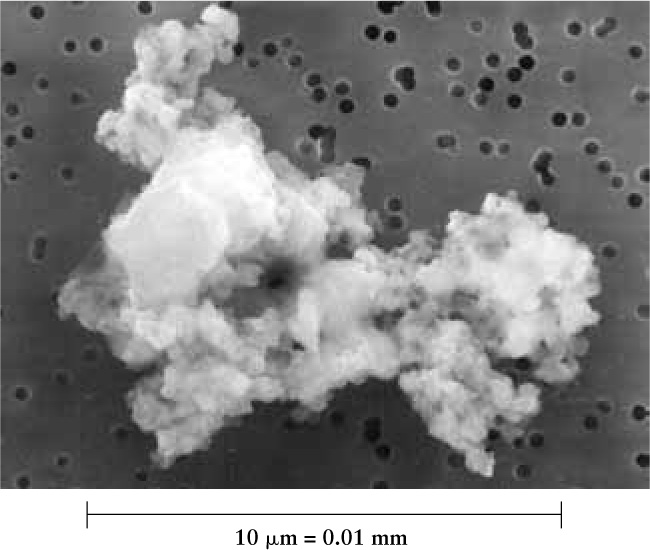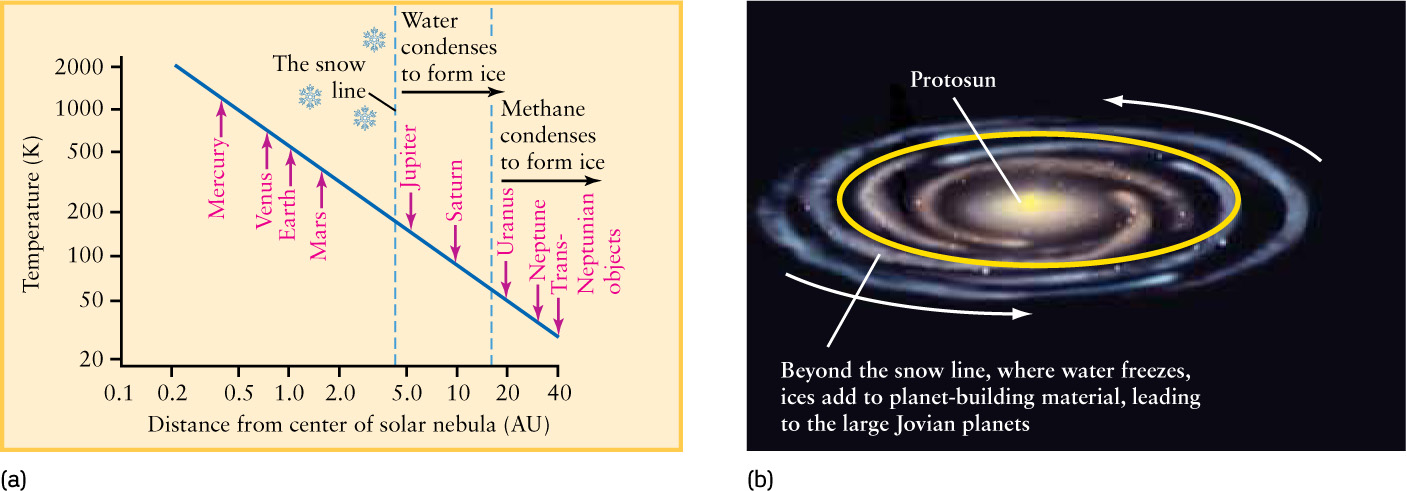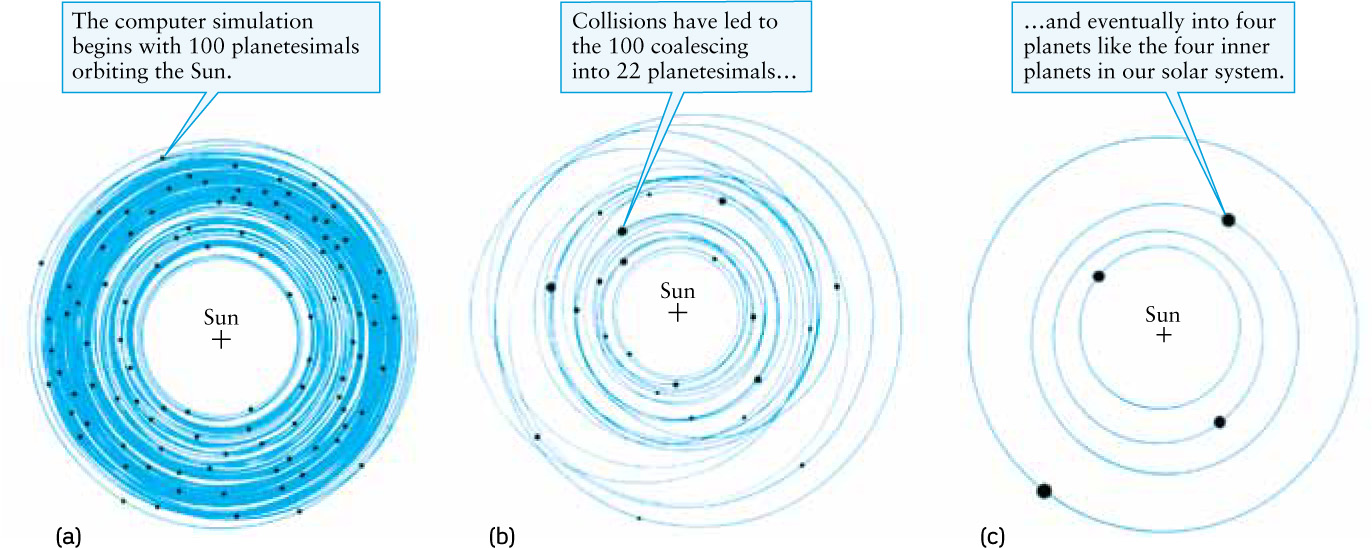8-5 The terrestrial planets formed by the accretion of planetesimals
Rocky planets formed in the inner solar nebula as a consequence of the high temperatures close to the protosun
We have seen how the solar nebula would have contracted to form a young Sun with a protoplanetary disk rotating around it. But how did the material in this disk form into planets? Why are the small terrestrial planets located in the inner solar system (Mercury, Venus, Earth, and Mars), while the giant Jovian planets are in the outer solar system (Jupiter, Saturn, Uranus, and Neptune)? In this section and the next we will see how the nebular hypothesis provides answers to these questions.
The Condensation Temperature and the Snow Line
To understand how the planets, asteroids, and comets formed, we start by considering a cold and low-pressure solar nebula, before it was warmed by an emerging protosun. At the low pressures that prevailed, a substance does not form into a liquid state, but must exist as either a solid or a gas. An example of such a solid is in Figure 8-9, which shows a dust grain of the sort that would have been present throughout the solar nebula. Other substances in the early solar nebula would have been in the form of small ice crystals (like snow), although at higher temperatures, these ices would evaporate to form a gas. Together, these solids—referred to as ices, dust grains, and ice-coated dust grains—were mixed with gaseous hydrogen and helium. But, then things began to heat up.

208
Due to Kelvin-Helmholtz contraction—the conversion of gravitational energy into thermal energy—a protosun began to form in the center of the nebula, and it was actually quite a bit more luminous than the present-day Sun. The temperature in the nebula varied significantly, rising above 2000 K closer to the hot protosun, and dropping below 50 K in the outermost regions (Figure 8-10a).

 Temperature Distribution and Snow Line in the Solar Nebula (a) This graph shows how temperatures probably varied across the solar nebula as the planets were forming, and the present-day position of the planets (red arrows). Note the general decline in temperature with increasing distance from the center of the nebula. Between the present-day distances of Mars and Jupiter, the snow line marked where temperatures were low enough for water to condense and form ice; beyond about 16 AU, methane (CH4) could also condense into ice. (b) Terrestrial planets formed inside the snow line, where the low abundance of solid dust grains kept these planets small. The Jovian planets formed beyond the snow line where solid ices of water, methane, and ammonia added their mass to build larger cores, and attract surrounding gas.
Temperature Distribution and Snow Line in the Solar Nebula (a) This graph shows how temperatures probably varied across the solar nebula as the planets were forming, and the present-day position of the planets (red arrows). Note the general decline in temperature with increasing distance from the center of the nebula. Between the present-day distances of Mars and Jupiter, the snow line marked where temperatures were low enough for water to condense and form ice; beyond about 16 AU, methane (CH4) could also condense into ice. (b) Terrestrial planets formed inside the snow line, where the low abundance of solid dust grains kept these planets small. The Jovian planets formed beyond the snow line where solid ices of water, methane, and ammonia added their mass to build larger cores, and attract surrounding gas.
Our first goal in determining a model for the origin of the solar system is to understand why the inner four planets are small and rocky, whereas the outer Jovian planets are large and made of lighter elements (recall Properties 1 and 3 in Table 8-1). To answer this, we first need to understand the condensation temperature, which determines when a substance forms a solid or a gas.
If the temperature of a substance in the solar nebula is above its condensation temperature, the substance is a gas. On the other hand, if the temperature is below the condensation temperature, the substance solidifies (or condenses) into tiny specks of dust or icy frost. You can often see similar behavior on a cold morning. The morning air temperature can be above the condensation temperature of water, while the cold windows of parked cars may have temperatures below the condensation temperature. Thus, water molecules in the warmer air remain as a gas (water vapor) but form solid ice particles (frost) on the colder car windows.
With heat from the emerging protosun, the solar nebula was radically changed into two distinct regions. These regions—inner and outer—had very different properties and eventually formed very different planets:
- Inner Region: rock and metal. In the hot inner region of the nebula, only substances with high condensation temperatures could have remained solid. These rocky and metallic materials, in the form of solid dust grains (Figure 8-9), eventually formed much of the rock and metal of the terrestrial planets. Hydrogen compounds—such as water (H2O), methane (CH4), and ammonia (NH3)—remained as gas; they could not condense into solids in the warm inner solar system. (Hydrogen and helium could not condense into solids anywhere in the solar system.) The terrestrial planets that formed in this inner region are Mercury, Venus, Earth, and Mars.
- Outer Region: ices beyond the snow line. In the area between the present-day orbits of Mars and Jupiter, the temperature dropped below around 170 K. In the low pressures of the solar nebula, this is the condensation temperature at which water vapor (H2O) forms ice (see Figure 8-10a). One aspect of this snow line—the distance from the Sun at which water vapor solidifies into ice or frost—is that beyond this line, the solid ice particles can join with rock and metal grains resulting in more mass to build planets (Figure 8-10b). Farther out, at even cooler temperatures, methane (CH4), and ammonia (NH3) also form ices. (Recall from Section 7-4 that “ice” can refer to frozen carbon dioxide, methane, or ammonia as well as to frozen water.) To summarize: Beyond the snow line, rocky and metallic dust grains were coated with frost, which means that additional icy mass went into building even larger planets. The Jovian planets that formed in this outer region are Jupiter, Saturn, Uranus, and Neptune.
209
The abundances of material in the solar nebula provide the final insight about planet sizes. With a mixture similar to the Sun, the solar nebula was composed of about 98% hydrogen and helium, about 1.4% hydrogen compounds (H2O, CH4, and NH3), and the remaining 0.6% of rocks and metals. Inside the snow line, the only solid material available to build planets consisted of rock and metal. Thus, with rock and metal having the lowest abundances, the inner terrestrial planets that formed from these dust grains are the smallest. On the other hand, beyond the snow line there was more solid mass available in the form of ice-coated dust grains to help build larger planets.
The phenomena described so far help us understand why smaller terrestrial planets formed close to the Sun, and larger Jovian planets formed farther out. However, there is more to this story, and some big mysteries remain. Next, we consider the process of building planets in more detail, beginning with the terrestrial planets.
Planetesimals, Protoplanets, and Terrestrial Planets
 In the inner part of the solar nebula, the grains of rocks and metals would have collided and merged into small chunks. Initially, electric forces—that is, chemical bonds—held these chunks together, in the same way that chemical bonds hold an ordinary rock together. Over a few million years, these chunks coalesced into roughly a billion asteroidlike objects called planetesimals, with diameters of a kilometer or so. These larger planetesimals were massive enough to be held together by their own gravity, resulting from the mutual gravitational attraction of all the material within the planetesimal.
In the inner part of the solar nebula, the grains of rocks and metals would have collided and merged into small chunks. Initially, electric forces—that is, chemical bonds—held these chunks together, in the same way that chemical bonds hold an ordinary rock together. Over a few million years, these chunks coalesced into roughly a billion asteroidlike objects called planetesimals, with diameters of a kilometer or so. These larger planetesimals were massive enough to be held together by their own gravity, resulting from the mutual gravitational attraction of all the material within the planetesimal.
During the next stage, gravitational attraction between different planetesimals caused them to collide and accumulate into around a hundred still-larger objects called protoplanets (also called planetary embryos), each of which was roughly the size and mass of our Moon. This accumulation of material to form larger and larger objects is called accretion. For about a hundred million years, these Moon-sized protoplanets collided to form the inner planets. This final episode must have involved some truly spectacular, world-shattering collisions. In fact, detailed modeling suggests that one of these protoplanet collisions with the forming Earth probably created our Moon! Snapshots from a computer simulation of accreting planetesimals are shown in Figure 8-11.


Primitive Meteorite This is a cross-section from a fragment of the Allende meteorite that landed in Chihuahua, Mexico, in 1969. A fireball was observed at 1:05 a.m. local time, and over the next 25 years about 3 tons of meteorite fragments were collected over an 8 km by 50 km area. Radioactive dating yields an age of 4.57 billion years, corresponding to the very early solar system. The meteorite contains rocks and metals that are consistent with the inner solar system and is thought to come from a smashed-up planetesimal.
In the inner solar nebula only materials with high condensation temperatures could form dust grains and hence protoplanets, so the result was a set of planets made predominantly of materials such as iron, silicon, magnesium, and nickel. In strong support for this model of solar system formation, these rocky and metallic materials match the composition of the present-day terrestrial planets. There is also supporting evidence from meteorites (dated from their radioactivity) that are thought to have come from smashed-up planetesimals during this early period. As expected for planetesimals from the inner solar system, these meteorites contain metallic grains mixed with rocky material (Figure 8-12).
At first the material that coalesced to form protoplanets in the inner solar nebula remained largely in solid form, despite the high temperatures close to the protosun. But as the protoplanets grew, they were heated by violent impacts as they collided with other planetesimals, as well as by the energy released from the decay of radioactive elements, and all this heat caused melting. Thus, the terrestrial planets began their existence as spheres of at least partially molten rocky materials. Material was free to move within these molten spheres, so the denser, iron-rich minerals sank to the centers of the planets while the less dense silicon-rich rocky minerals floated to their surfaces. This process is called chemical differentiation (see Box 7-1). In this way the terrestrial planets developed their dense iron cores.
210
CONCEPT CHECK 8-7
How might the solar system be different if the location at which water could freeze in the solar nebula was much more distant from the Sun than it was in the solar nebula that formed our solar system?
CONCEPT CHECK 8-8
How does a rocky planet develop a core that has a higher density than rocks on its surface?